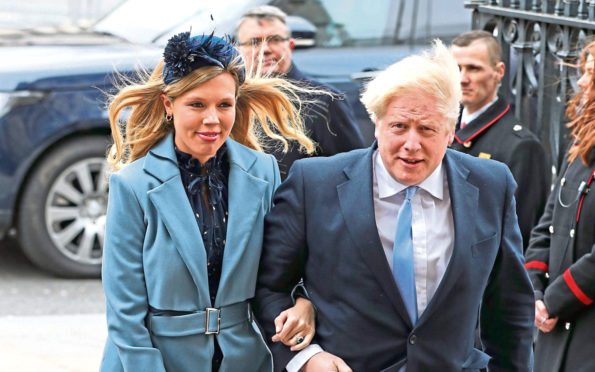The luckiest thing for Boris’ career was getting ill. A virus that should have been his political demise has become his renaissance. Going into the pandemic crisis, things were not looking good for the Johnson administration.
For the first time in history, a chancellor had resigned before delivering a Budget. Sajid Javid left with bitter words about the state of the Boris regime.
Priti Patel announced an immigration policy so self-harming it’s a wonder she was not pictured cutting off her nose. The proposed restriction on letting people into the country was hammered by businesses for the damage it could do to the economy.
For many in England and Wales, these were Westminster bubble issues compared with the real threat from floods. Parts of the south were submerged and Boris was posted missing when it came to the visuals of looking serious in a disaster.
At the end of February the prime minister announced that he was engaged to his live-in lover Carrie Symonds and that they were expecting a child. Commentators framed this as a rare beam of light in an otherwise dark stretch for Boris.
Perhaps it was because the soprano-pitched hysterics of Brexit had ended that the public was slow to grasp this was not a united or effective government. If the public needed evidence, it would come in the form of the virus response.
Today we expect the UK lockdown to be extended for another three weeks. At the same time, other developed European nations are beginning to relax their stay-at-home rules.
The UK has recorded some of the highest death rates in the world from the virus. The single worst mortality rate in a day in Europe occurred in Britain, not Spain or Italy.
While German and French health workers are supplied with personal protective equipment (PPE), a row washes back and forth in Britain about why there is so little kit, what did the Government do wrong, denials from Matt Hancock, apologies from Priti Patel, then new assertions that everyone is properly dressed.
We do not have enough testing kits. The truth is we have no idea how many people are infected and only a rough sense of how many people died from the virus. It seems no one thought about care homes at all.
England and Wales recorded their highest ever death rate since records began. Scotland is little better. As of yesterday, more than 12,000 people have died from the virus in the UK.
This was no surprise attack. In January, we learned of a new virus in China which had killed about 40 people. We had plenty of time to prepare. Six weeks later, we watched in horror at the pandemonium in Italian hospitals. We still had to time to act. We didn’t.
An investigation by Reuters news agency suggests scientists were slow in pressing the scale of the threat. On March 2, an advisory committee warned of more than 500,000 deaths in the UK.
The next day Boris Johnson said “our country remains extremely well prepared” and the UK Government’s chief medical adviser Chris Witty downplayed the prediction.
Reuters’ investigation says the UK was slow to start modelling, driven by a sense that Britons would never accept lockdown. In response, the UK Government’s top scientific adviser Patrick Vallance says it’s not true that modelling didn’t start until March and that it was under way in February.
Two days after the Reuters report, Chris Witty said the UK should have acted sooner.
He said: “We all know that Germany got ahead in terms of its ability to do testing for the virus and there’s a lot to learn from that and we’ve been trying to learn the lessons from that.”
At this time Boris was being Boris – making light of his own Government’s advice about shaking hands with nurses.
He assured us that the virus would also be done “within 12 weeks” before going off to Twickenham to sit with 80,000 people. No scientific source has been provided for the 12 weeks remark.
Meanwhile, Health Secretary Hancock had failed to impose proper checks. The UK’s patient zero returned from ski-ing holidays with the virus but was not monitored on arrival. The World Health Organisation’s advice to trace and track the infection was ignored.
By any normal standard, Boris should be a hate figure. A man self-billed as “good in a crisis” has been exposed as awful.
That Boris caught the virus is itself a condemnation of his government. At the very centre of the advice, better informed than any of us, he treated the risk as a minor thing. He is the only leader of a government in the entire world to get ill. And yet it’s his saviour.
Absent from the TV screens when Matt Hancock and Dominic Raab blethered in his place, he’s not associated with the broken promises on PPE and tests.
Instead he’s become the redemptive figure, the leader who has risen again. His ode to the NHS cleanses him of responsibility for the deaths among frontline workers. Just as the buck stopped with him, he went to hospital. And so he goes on.











